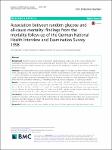Association between random glucose and all-cause mortality: findings from the mortality follow-up of the German National Health Interview and Examination Survey 1998
Baumert, Jens
Heidemann, Christin
Paprott, Rebecca
Du, Yong
Scheidt-Nave, Christa
Background
Random glucose is widely measured in epidemiological studies and in the clinical setting when standardized fasting protocols and oral glucose tolerance testing or HbA1c measuring are not feasible. The relationship between random glucose and all-cause mortality has hardly been studied so far and was examined in the present study.
Methods
We ascertained mortality status among 5955 persons aged 18–79 years and free of known diabetes when participating in the German National Health Interview and Examination Survey 1998 (mean observation time 11.7 years, 458 deaths). Cox regression was applied to analyze the association of random serum glucose with all-cause mortality taken potential confounders into account. Relative mortality risks were estimated as hazard ratios (HRs) with 95% confidence intervals (CIs) modeling random glucose as categorical or continuous variable.
Results
Compared to random glucose levels of 4.3 - < 5.3 mmol/L, HRs (95% CIs) were 1.94 (0.85–4.45) for levels < 4.3 mmol/L and 1.16 (0.89–1.50), 1.20 (0.91–1.58), 1.42 (0.88–2.29), 2.02 (1.26–3.25) and 4.71 (2.20–10.10) for levels 5.3 - < 5.8, 5.8 - < 6.8, 6.8 - < 7.8, 7.8 - < 11.1 and ≥ 11.1 mmol/L, adjusted for age, sex, lifestyle, anthropometry and chronic diseases. An additional adjustment for fasting time or HbA1c yielded similar estimates. Modeling continuous random glucose by restricted cubic spline functions revealed comparable findings.
Conclusions
In the present epidemiological study drawn from the general population, random glucose showed a significant association with all-cause mortality, independent of main potential confounders. Thus, random glucose measures are highly relevant to health risk assessment among people without known diabetes when fasting glucose or HbA1c are difficult to obtain.
Dateien zu dieser Publikation

